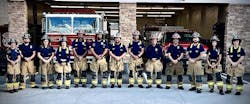Volunteer View: A New Chief’s Guide to Increasing Volunteers
One of the most common complaints that I hear from chiefs of volunteer departments is “Nobody wants to volunteer anymore.” The data also support this, with the National Volunteer Fire Council citing that the number of volunteer firefighters reached a low in 2020.
Despite this troubling trend, there are things that chiefs can do to turn the tide of low attendance. Over the past year, my department more than doubled its attendance at meetings and calls and increased its overall membership. Nothing that we did was revolutionary or expensive, but it makes all the difference in getting people through the doors and to the fireground.
Improvements to increase appeal
Nobody wants to join an organization that’s failing. When I was elected chief of my department, it faced historically low attendance levels. It was tempting to immediately start to recruit.
Instead, we focused inward before we turned to the community. We focused on our training and administrative duties and worked to be the best version of what we could be. Months were spent developing training plans, working on grants and even cleaning the station. It was important to us that the people who we still wanted to be here felt that we cared.
Having training plans that were well thought out allowed weekly meeting nights to have a higher sense of organization. This showed firefighters that we cared enough to put in the effort to the training that they volunteered to be at to make it the best that it could be. Instead of wasting nights on chalkboard burns and calling training early, we engaged in hands-on training and focused on making training fun again.
Grants needed to be written to improve PPE. Nothing shows a firefighter that you don’t care about them more than not putting in the time to find the funds to replace their old, outdated and full-of-holes structural boots. Our philosophy quickly became “If they are willing to risk their life for this department, the least that we can do is to make sure that they have the gear to do the job safely.” Grants always are a complicated subject, but some Google searches quickly revealed hundreds of private organizations that are willing to give grant money for deserving cases.
Cleaning the station might sound insignificant in the scheme of things, but that couldn’t be further from the truth. Putting in the time as a chief shows your firefighters that you care enough to do the tasks that nobody wants to do (think: cleaning the cupboard in the back of the station). Having a clean, welcoming environment at the fire hall allows members to feel more comfortable while they are there and, hopefully, translates to them wanting to be there more often.
These efforts were rewarded. We now had a core group of firefighters who appreciated all of the work that we did to improve conditions. This core group became more active than ever and attended every event, training and call. Others in the community saw this effort and responded by applying. Soon, as people saw that we were no longer a sinking ship, they came in droves.
What people bring to the table
Firefighter stereotypes exist. We all have an image of what a firefighter should be. Learning to challenge this image can be difficult, but, ultimately, finding the value that nontraditional volunteers bring to the table is a skill that every volunteer chief should have.
We have a saying in our department: There is a job for everyone. Not everyone who walks into the bays and wants to volunteer is capable of kicking in doors, hiking miles to wildland fires and lifting vehicles single handedly, and that’s OK. We also need people to run traffic control, operate the radios and change SCBA bottles.
There also is tremendous value in community members who volunteer for nonoperational roles. For instance, having someone who has an accounting background help with the annual budget and getting a retired schoolteacher to look over a task book for grammatical errors are great ways to use volunteers’ backgrounds and experience to better a department.
Everyone who is willing to volunteer adds value. The trick is to learn how to capitalize on their contribution and how to manage a team so that everyone does the job that they are best at without sacrificing standards. Communities must come first, and, ultimately, having people in roles that best fit their strengths is what’s best for a community.
Expanding your image of what a firefighter is allows you to bring more diversity of strengths to your department. For us, this diversity meant more compassion for patients, greater community relations and a smoother operation overall.
Don’t discredit baked goods
Every leadership book that I read has a section on team morale. Study after study shows that increased team morale improves team performance. I would add that also leads to increased participation.
Volunteer firefighters don’t do this job to pay their mortgage. They do this job because they love it. It’s the duty of department leadership to ensure that they continue to love it, even during the difficult times.
Early in my tenure, I found myself becoming hyper fixated on the clerical side of the job. My days consisted of trying to create the perfect department on paper, and I failed to see that perfect departments don’t exist in spreadsheets; they exist in their people. I changed our focus from metrics and data points and instead looked to the morale of the department and how to best increase it.
Little tokens of appreciation, such as bringing pizzas to training night, handwritten birthday cards and even cupcakes to celebrate our team’s achievements, suddenly made all the difference.
Of course, as a chief, I always appreciated my volunteers, but I never showed them my appreciation until then. People suddenly felt valued and that the work that they were doing was seen and, most importantly, recognized.
These actions—including, as silly as it might sound, baked goods—helped our department to overcome any lingering morale issues.
Do what you can
Taking the reins of a volunteer department can be challenging and isn’t without its pitfalls. That said, it’s the duty of chiefs to do everything that’s in their power to increase membership, participation and morale. Citizens deserve nothing less, and at the end of our career, we all should be able to say that we did everything that we could, whether it’s focusing inward, looking for talent in unlikely places or bringing baked goods to training night.
PRODUCT SPOTLIGHT
Dispatch Notification
eDispatches, which is a RapidSOS solution, is a leading emergency dispatch notification service for first responders. It delivers real-time alerts via text, phone and app, to ensure quick and reliable communication during emergencies. With features that include voice dispatch, mapping and CAD messaging integration, the system streamlines response efforts while enhancing team coordination and public safety effectiveness.
Emergency Services Insurance
In a world of insurance that’s driven by bargain pricing, arm’s-length service and one-size-fits-all policies, ESIP offers a depth of knowledge and industry expertise to serve the real needs of fire and rescue service organizations. For more than 30 years, the company has lived and breathed the emergency services category, developing industry-tailored coverages and a proactive approach that helps to anticipate issues before they occur.
About the Author

Nick Way
Nick Way is the fire chief for the Bridgeport Fire Protection District in California’s Eastern Sierra Nevada Mountains and is a 15-year veteran of the fire and emergency services. He holds a bachelor’s degree and is completing his master’s degree in organizational leadership from Columbia Southern University. Way is completing his credentials for Chief Fire Officer through the Center for Public Safety Excellence.


